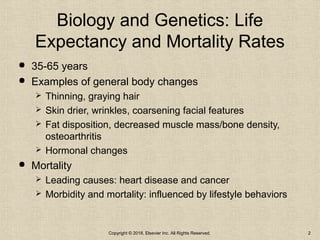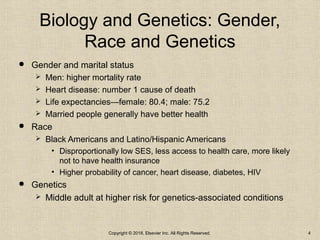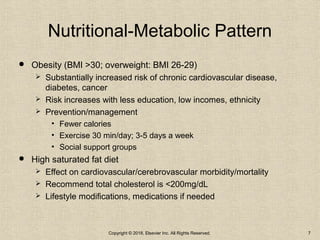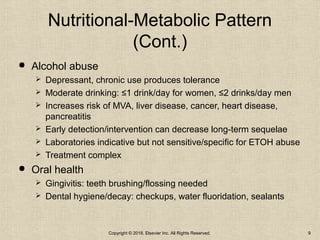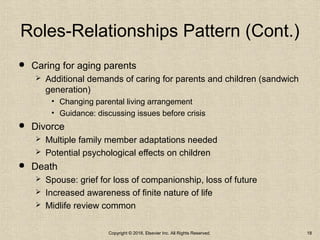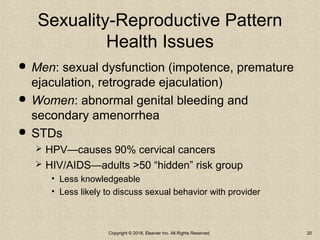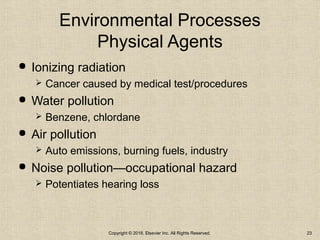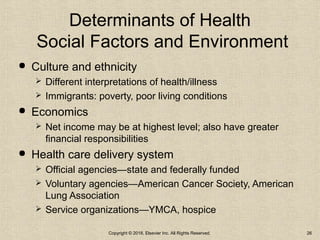Middle Age Adult
- 1. Middle-Age Adult Jacey Mitchell, RDH, MS Fall 2018 Copyright © 2018, Elsevier Inc. All Rights Reserved.
- 2. Biology and Genetics: Life Expectancy and Mortality Rates 35-65 years Examples of general body changes Thinning, graying hair Skin drier, wrinkles, coarsening facial features Fat disposition, decreased muscle mass/bone density, osteoarthritis Hormonal changes Mortality Leading causes: heart disease and cancer Morbidity and mortality: influenced by lifestyle behaviors Copyright © 2018, Elsevier Inc. All Rights Reserved. 2
- 3. Common Health Problems Middle-Aged Adult Kyphosis: angulation of posterior spine Osteoarthritis: degenerative joint disease Osteopenia: subnormal bone mineralization Osteoporosis: abnormal loss of bone density Constipation: decreased stool frequency Menopause: cessation of menses Erectile dysfunction in males Copyright © 2018, Elsevier Inc. All Rights Reserved. 3
- 4. Biology and Genetics: Gender, Race and Genetics Gender and marital status Men: higher mortality rate Heart disease: number 1 cause of death Life expectancies—female: 80.4; male: 75.2 Married people generally have better health Race Black Americans and Latino/Hispanic Americans • Disproportionally low SES, less access to health care, more likely not to have health insurance • Higher probability of cancer, heart disease, diabetes, HIV Genetics Middle adult at higher risk for genetics-associated conditions Copyright © 2018, Elsevier Inc. All Rights Reserved. 4
- 5. Gordon’s Functional Health Patterns Health perception–health management pattern Nutritional-metabolic pattern Elimination pattern Activity-exercise pattern Sleep-rest pattern Cognitive-perceptual pattern Self-perception–self-concept pattern Roles-relationships pattern Sexuality-reproductive pattern Coping–stress tolerance pattern Values-beliefs pattern Copyright © 2018, Elsevier Inc. All Rights Reserved. 5
- 6. Health Perception– Health Management Pattern Habits: self-destructive Smoking, alcohol, overeating Visible consequences Risk factors: behavioral/environmental Age, gender, race, personal risks Health-promotion needs • Health screening of diseases/behaviors • Stop self-destructive behaviors • Exercise Copyright © 2018, Elsevier Inc. All Rights Reserved. 6
- 7. Nutritional-Metabolic Pattern Obesity (BMI >30; overweight: BMI 26-29) Substantially increased risk of chronic cardiovascular disease, diabetes, cancer Risk increases with less education, low incomes, ethnicity Prevention/management • Fewer calories • Exercise 30 min/day; 3-5 days a week • Social support groups High saturated fat diet Effect on cardiovascular/cerebrovascular morbidity/mortality Recommend total cholesterol is <200mg/dL Lifestyle modifications, medications if needed Copyright © 2018, Elsevier Inc. All Rights Reserved. 7
- 8. Nutritional-Metabolic Pattern (Cont.) Calcium Recommendations: nonpregnant adults: 1000 mg; postmenopausal women without hormones: 1500 mg Absorption enhanced by vitamin D Caffeine Readily accessible Stimulant; be aware of addiction potential Controversy over health effects of moderate consumption High-sodium diet Role in hypertension; increases fluids, increases vascular resistance Copyright © 2018, Elsevier Inc. All Rights Reserved. 8
- 9. Nutritional-Metabolic Pattern (Cont.) Alcohol abuse Depressant, chronic use produces tolerance Moderate drinking: ≤1 drink/day for women, ≤2 drinks/day men Increases risk of MVA, liver disease, cancer, heart disease, pancreatitis Early detection/intervention can decrease long-term sequelae Laboratories indicative but not sensitive/specific for ETOH abuse Treatment complex Oral health Gingivitis: teeth brushing/flossing needed Dental hygiene/decay: checkups, water fluoridation, sealants Copyright © 2018, Elsevier Inc. All Rights Reserved. 9
- 10. Elimination Pattern Constipation Risk: age, sedentary lifestyle, lack of dietary bulk Dietary fiber preferable to laxatives and fiber products Stress incontinence Risk: women with multiple births, little exercise Copyright © 2018, Elsevier Inc. All Rights Reserved. 10
- 11. Activity-Exercise Pattern Exercise benefits Prevent/manage chronic illness (heart, diabetes, osteoporosis, depression, cancer) Significant increase in life expectancy/quality of life Exercise recommendations 30 minutes, 5 or more days/week Continuous, rhythmic exercise (e.g., walking, jogging, swimming, bicycling) Initiating exercise program Choose activities enjoyed in past (if appropriate) Consider potential for injury, proper equipment Exercise testing if high risk Copyright © 2018, Elsevier Inc. All Rights Reserved. 11
- 12. Sleep-Rest Pattern Compared to young adults Less time in deep sleep Less sleep overall Healthful guidelines Regularly scheduled Quality sleep Occasional napping Cognitive-behavioral therapy for sleep problems Sleep apnea common disorder adults Disordered breathing during sleep Copyright © 2018, Elsevier Inc. All Rights Reserved. 12
- 13. Cognitive-Perceptual Pattern Intellectual ability—learning continues thru life Adult continues to accumulate “learning” intelligence Piaget’s stage of formal operations Can process complex problems of reasoning Bloom’s hierarchy of cognitive levels of the adult learner (1) knowledge, (2) comprehension, (3) application, (4) analysis, (5) synthesis and evaluation Schaie’s factors that maintain cognitive function Focus on involvement, absence of chronic disease, flexibility, family, complexity, favorable SES, personal satisfaction, spouse with high cognitive function Copyright © 2018, Elsevier Inc. All Rights Reserved. 13
- 14. Cognitive-Perceptual Pattern Perceptual Changes Presbyopia (farsightedness) Glaucoma: increased intraocular pressure Decreased visual sensitivity and peripheral vision Cataracts: opacity of lens Diabetic retinopathy Presbycusis: loss of higher frequency hearing Diminished sense of taste Macular degeneration: deterioration of retina Copyright © 2018, Elsevier Inc. All Rights Reserved. 14
- 15. Self-Perception–Self-Concept Pattern Levinson’s theory—“individual life structures” Age-associated seasons—midlife transition Reappraisal lie, integrate polarities, modify/move to goals Struggles with meaning, value, direction of lives Erikson’s theory—generativity vs stagnation Generativity: sense of productivity, creativity, caring for others Stagnation: lack of accomplishment, self-absorption Physiological changes Affects on self-esteem: graying hair, wrinkles, body shape Perimenopause and menopause: • Mood swings, nervousness, fatigue, depression • Hormonal therapy: indications and controversy • Alternative products: little scientific data on benefit Copyright © 2018, Elsevier Inc. All Rights Reserved. 15
- 16. Roles-Relationships Pattern “Midlife crisis” Time of reassessment, turmoil, change Family Family life cycle • Families with children (ages 13-20) • Families launching young adults • Families from empty nest to retirement Multiple responsibilities and stresses • Children, aging parents, job, and civic responsibilities • Single parent families, adult children at home • “Empty-nest syndrome” • Over-involvement with children’s activities Copyright © 2018, Elsevier Inc. All Rights Reserved. 16
- 17. Roles-Relationships Pattern (Cont.) Work Plays major role in level of wellness, self-esteem 10 million work-related injuries yearly Two-or-more job family Role changes—family stress factors • Reentering workforce • Job-related travel • Nontraditional female/male roles • Nature of parental work environment • Retirement planning/midcareer changes Elements of work site health-promotion programs Copyright © 2018, Elsevier Inc. All Rights Reserved. 17
- 18. Roles-Relationships Pattern (Cont.) Caring for aging parents Additional demands of caring for parents and children (sandwich generation) • Changing parental living arrangement • Guidance: discussing issues before crisis Divorce Multiple family member adaptations needed Potential psychological effects on children Death Spouse: grief for loss of companionship, loss of future Increased awareness of finite nature of life Midlife review common Copyright © 2018, Elsevier Inc. All Rights Reserved. 18
- 19. Sexuality-Reproductive Pattern High proportion adults remain sexually active Pregnancy 77% pregnancies unintended—perimenopause Higher risk of maternal death, fetal complications Changes in reproductive system Slower arousal, orgasms less intense, long refractory between erection and ejaculation, vaginal dryness, decreased libido American cultural value on youth and beauty is challenging for middle-aged woman Copyright © 2018, Elsevier Inc. All Rights Reserved. 19
- 20. Sexuality-Reproductive Pattern Health Issues Men: sexual dysfunction (impotence, premature ejaculation, retrograde ejaculation) Women: abnormal genital bleeding and secondary amenorrhea STDs HPV—causes 90% cervical cancers HIV/AIDS—adults >50 “hidden” risk group • Less knowledgeable • Less likely to discuss sexual behavior with provider Copyright © 2018, Elsevier Inc. All Rights Reserved. 20
- 21. Coping–Stress Tolerance Pattern Factors related to coping with stress and health outcomes Stress hardiness—control, commitment, challenge Tranquilizer use <50 Maturity of defenses against stress Framingham study: worry, conflict, anger, ambitiousness affect BP Coping with death of a parent Preparation helps feelings of control Examples: living will, advanced directive, durable power of attorney Copyright © 2018, Elsevier Inc. All Rights Reserved. 21
- 22. Values-Beliefs Pattern Beliefs formed early; reviewed during crisis Middle-age moral transitions: valuing others, having relationships, responsibility to others Developmental theories Erikson: caring as middle-age adult virtue Kohlberg: conventional and postconventional phases Gilligan: gender differences in moral development • Women: Selfishness vs responsibility, avoid hurting others • Men: justice, fairness, rights of individuals Copyright © 2018, Elsevier Inc. All Rights Reserved. 22
- 23. Environmental Processes Physical Agents Ionizing radiation Cancer caused by medical test/procedures Water pollution Benzene, chlordane Air pollution Auto emissions, burning fuels, industry Noise pollution—occupational hazard Potentiates hearing loss Copyright © 2018, Elsevier Inc. All Rights Reserved. 23
- 24. Environmental Processes Biological Agents Transmitted through air or food/water Enter respiratory or gastrointestinal tract Examples Hepatitis A: fecal-oral route, poor sanitation Hepatitis B • Blood-borne pathogen • Occupational hazard: health professionals Pneumonia: vaccine available Herpes zoster (Shingles) vaccine available Copyright © 2018, Elsevier Inc. All Rights Reserved. 24
- 25. Environmental Processes Chemical Agents Contaminants from workplace industry Pneumoconiosis—black lung disease (coal) Asbestos: mesothelioma Organic carcinogens: benzene, PVC, others Tobacco Middle age: may have 30+ packs per year history Risk of heart/lung disease/cancer increased 2000 known chemicals in cigarettes • Tar, cyanide, formaldehyde, carbon monoxide Copyright © 2018, Elsevier Inc. All Rights Reserved. 25
- 26. Determinants of Health Social Factors and Environment Culture and ethnicity Different interpretations of health/illness Immigrants: poverty, poor living conditions Economics Net income may be at highest level; also have greater financial responsibilities Health care delivery system Official agencies—state and federally funded Voluntary agencies—American Cancer Society, American Lung Association Service organizations—YMCA, hospice Copyright © 2018, Elsevier Inc. All Rights Reserved. 26
- 27. Levels of Policy Making High cost of health care Changes in economy result in changes in family patterns: housing, education Aging population utilizes more health resources Unemployment creates stressors Technology creates employment changes Health organizations and delivery services Affordable Care Act and political controversy Copyright © 2018, Elsevier Inc. All Rights Reserved. 27

